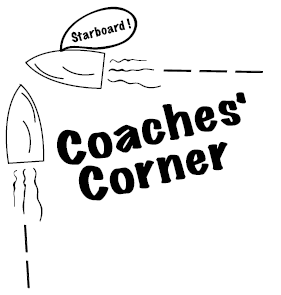by CLEMMIE EVERETT
Coordination and communication between skipper and crew as well as between teammates is essential.
If you’re participating in a high school sailing program this spring, you’re probably trying to make sense of team racing. Even if you have team raced before, early spring is always a good time for a refresher. Team racing on the high school level involves six boats, ‘three on a team’ and the objective is to finish with fewer points than your opponent. This often means that, counter to your habits from fleet racing, there will be situations on the race course when it is to your advantage to slow down or even stop your boat, as well as situations where you will let others (your teammates) pass you on the racecourse.

If you want to be a good team racer, the first thing you need to work on is boatspeed and boathandling. If you can’t keep up with your teammates and opponents, can’t maneuver in close situations with marks and other boats, and can’t slow your boat down and then accelerate again, you won’t be much help to your team. Coordination and communication between skipper and crew as well as between teammates is essential.
The next step in learning team racing is to become familiar with winning and losing combinations. If in doubt, any combination that adds up to less than ten is winning, and anything greater than ten is losing. Another rule of thumb is that if you have first place and not last place, your team is always winning. But team races are won and lost in a matter of seconds, and to act quickly, you will need to know combinations almost instantly. There are three stable winning combinations:
1-2-x, also called Play 1
2-3-4, also called Play 2
1-4-5, also called Play 4
These combinations are stable because they are easy to defend, though in team racing, as in sailing in general, nothing is guaranteed until you actually cross the finish line. Play 1 is stable because it is difficult for opponents to catch your first two boats. The third boat on your team should try to stay out of protests and slow the back half of the race down if possible. Play 2 is stable because the three boats can cover the opponent’s two boats behind, and it is difficult for the opponent in first to attack all three of your team’s boats without losing the lead. Play 4 is more complex, but it boils down to the first place boat being able to hold the lead and the fourth and fifth place boats holding the last place opponent in last.
There are also two unstable winning combinations:
1-3-x
2-3-5
These combinations are unstable because they create opportunities for your opponent to attack. In fact, the key to converting a losing combination into a winning one is the ability to quickly recognize and act on these opportunities. So, if you find yourself in a 2-4-5 or a 2-4-6, you need to realize that the opponent has a 1-3, and you must prevent your opponent from securing a 1-2. Your boat in second place must slow the opponent in third enough to let a teammate pass through. If you find yourself with a 1-3, and your first place boat can slow the opponent in second enough to let the third place boat pass through into first, then you have a 1-2, and you can simply sail to the finish while putting a loose cover on your opponents. In the same way, if you have a 2-3-5, and your team can slow your opponent in fourth to let fifth place move ahead, then you have a 2-3-4, Play 2.
How you actually slow your opponents down and pass your teammates is a discussion for another day, but once you know what sort of combination you are in, you know what your immediate objective is. If you find yourself in an unstable winning combination, try to convert to a stable combination. In a stable winning combination, make the race move quickly and get to the finish line as soon as you can. This means herding opponents to laylines and avoiding tacking duels. In a losing combination, you will need to attack the opponent and do whatever you can to slow the race down: avoid laylines and try to create situations where your opponent might make a tactical or boathandling mistake.
It’s worth taking some time to look at different combinations and think about how each side can convert to a stable winning combination. For instance, in a 1-4-6 (your opponent is 2-3-5), you are losing, but if you can move to a 1-4-5, you’re in great shape. How do you do this? The next steps in developing team race skills will be to learn passbacks and mark traps (next month).
Clemmie Everett is the Assistant Sailing Coach at Rye Country Day School in Rye, NY and the Sailing Director at Noroton Yacht Club in Darien, CT.




